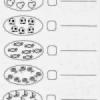
It is the main source of energy in the world today. This is mainly due to the ease of transport and low rate of energy loss during conversions.
Hydroelectric power plants are the most common places to produce electricity. About 20% of the world's electricity is produced in these plants. However, it can also be done in wind, solar, thermoelectric, nuclear power plants, etc.
The electric power generation occurs from the electric potential of two points of a conductor, which generates an electric current. In other words, it is the ability of an electric current to do work.
The process of producing electricity in hydroelectric power plants, for example, is carried out by the following process: the force of the waters, of the rivers, is used to generate mechanical energy which, in turn, is transformed into energy electric.
In order for electrical energy to reach final consumers (companies, homes, schools, etc.), energy follows the following path:
Initially, the process begins at the Generator Plant (hydroelectric, wind or others), then goes to the generator, later lifting substation, transmission lines, lowering substation, transformer, lighting poles, distribution until reaching the final costumer.
There are several types of electrical energy, and some can last forever, but others need resources that are finite. These are the well-known renewable and non-renewable sources.
The sources that regenerate in nature and, therefore, do not cause environmental problems and do not run out are the so-called renewable sources. Are they:
The sources that cause several environmental problems if not consumed in a rational way, are the so-called non-renewable sources. Are they:
Today's society depends exclusively on electricity for various tasks. The world of work-agriculture, industry, services, commerce, leisure, for its effective functioning, needs this type of energy to perform its routine tasks.
It is of fundamental importance because it can be converted to generate light, power to move motors, maintenance of food in refrigerators and freezers, air conditioning, hot shower and running various electrical and electronic products that we have at home (computer, refrigerator, microwave, shower, etc.).
In Brazil, almost 90% of the energy is produced in hydroelectric plants, with the largest hydroelectric plant in Brazil is the Itaipu Power Plant, a binational power plant, since it is located on the Paraná River, on the border between Brazil and Paraguay.
Behind China and Russia, Brazil has the third largest hydraulic potential on the planet (large rivers). Given this, the Brazilian government intends to invest in the construction of more hydroelectric plants.
1. Itaipu Hydroelectric Power Plant, on the Paraná River – Capacity: 14,000 MW;
2. Tucuruí Hydroelectric Plant, Tocantins River – Capacity: 8,370 MW;
3. Ilha Solteira Hydroelectric Plant, on the Paraná River – Capacity: 3,444 MW;
4. Xingó Hydroelectric Power Plant, on the São Francisco River – Capacity: 3,162 MW;
5. Foz Do Areia Hydroelectric Plant, on the Iguaçu River – Capacity: 2,511 MW;
6. Paulo Afonso Hydroelectric Plant, on the São Francisco River – Capacity: 2,462 MW;
7. Itumbiara Hydroelectric Power Plant, on the Paranaíba River – Capacity: 2,082 MW;
8. Teles Pires Hydroelectric Plant, on the Teles Pires River – Capacity: 1,820 MW;
9. São Simão Hydroelectric Power Plant, on the Paranaíba River – Capacity: 1,710 MW;
10. Jupiá Hydroelectric Power Plant, on the Paraná River – Capacity: 1,551 MW.


